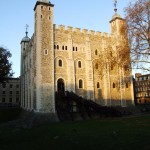TOWER OF LONDON
The Tower throughout its nine hundred year history has been a castle, a royal residence, an armoury and a treasury as well as a prison and a place of executions.
In 1066, Duke of Normandy William began the conquest of England. By the end of the Anglo-Saxon period, London became the leading city in England with a rich port, a royal palace located nearby and the main cathedral. Providing the city’s safety was William’s main goal during his reign. He gave an order to begin construction of a fortress around the city. In this way in 1100 the construction of the White Tower was completed. The Tower is protected by huge walls from the northern, western and southern sides. In 1377, all the buildings in the Tower were finished. On the territory of the Tower there are:
- The Crown Jewels. Since the beginning of XIV century, the Tower is the location of the world wide famous Treasury of the British Crown. Seeing the Royal regalia still used by the Queen and members of her family is an important part of visiting the Tower.
- The Medieval Palace was the residence of kings and queens. The Chambers look like they were at the time of Edward I (1272-1307). One can see an exhibition speaking about restoration of the facilities on display.
- Pedestrian wall tour. The Tower of London is surrounded by a circle of massive defensive walls. Excursion along the eastern part tells about the use of the fortress towers since XIII century.
- The Martin Tower. In this tower there’s an exhibition “The Diamonds and Crowns: Making of Royal Jewelry” (presented together with De Beers).
- The White Tower, founded at the time of William the Conqueror (1066 – 1087), started the long history of the famous London Tower. Originally the White Tower’s purpose was to protect the Royal Family in case of public disorder. There’s an exhibition of the armour of the kings and tools of torture here.
- The Tower Green. It is near the Tower Green that some of the most famous convicts of the Tower including Sir Walter Raleigh (13 years in the Bloody tower) were kept. On the site of executions two wives of Henry VIII were beheaded (Anne Boleyn and Catherine Howard). Worship services in St. Peter ad Vincula church take place on Sunday mornings (excluding August). At other times sightseeing of the church is available after 4:30 p.m. as part of an organized excursion conducted by a yeoman – a ward.
- Western Entrance & Water Lane. If you enter through the Western entrance you will get an idea of how the Tower was defended from attacks. In the Water lane you will see the Traitors’ Gate, through which many famous prisoners were brought into the Tower for the last time.
- The Fusiliers Museum. Since the moment of its foundation until this day army has always been present in the Tower. Today the Museum of the Royal Fusiliers’ regiment is open here. Since it is a separate museum, entry into it costs another 50 pence.
- The Yeoman Warders. The Yeoman Warders (often called “beefeaters”) have been in the Tower since XIV century. Today they are not only an essential part of traditional ceremonies but also tour guides of the Tower.
- The Tower Ravens. Ravens are one of the most famous sights of interest of the Tower of London. According to a legend, if the ravens leave the Tower the English monarchy will fall.

